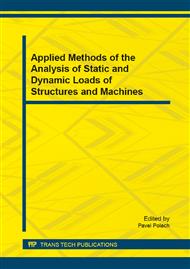[1]
G. Donzella, M. Faccoli, A. Mazzu, C. Petrogalli, R. Roberti, Progressive damage assessment in the near-surface layer of railway wheel-rail couple under cyclic contact, Wear 271 (2011) 408-416.
DOI: 10.1016/j.wear.2010.10.042
Google Scholar
[2]
D.I. Fletcher, J.H. Beynon, Equilibrium of crack growth and wear rates during unlubricated rolling-sliding contact of pearlitic rail steel, Proceedings of the Institution of Mechanical Engineers Part F 214 (2000) 93-105.
DOI: 10.1243/0954409001531360
Google Scholar
[3]
W.R. Tyfour, J.H. Beynon, A. Kapoor, Deterioration of rolling contact fatigue life of pearlitic rail due to dry-wet rolling-sliding line contact, Wear 197 (1996) 255-265.
DOI: 10.1016/0043-1648(96)06978-5
Google Scholar
[4]
A. Kapoor, F.J. Franklin, Tribological layers and the wear of ductile materials, Wear 245 (2000) 204-215.
DOI: 10.1016/s0043-1648(00)00480-4
Google Scholar
[5]
O. Umezawa, S. Morooka, J. Brumek, Subsurface crack generation and flanking under rolling contact fatigue, in: Proceedings of the Conference New Methods of Damage and Failure Analysis of Structural Parts, Ostrava, 2012, pp.421-427.
Google Scholar
[6]
J.E. Merwin, K.L. Johnson, An analysis of plastic deformation in rolling contact. Proceedings of the Institution of Mechanical Engineers 177 (1963) 676-685.
DOI: 10.1243/pime_proc_1963_177_052_02
Google Scholar
[7]
A. Mazzu, A simplified non-linear kinematic hardening model for ratcheting and wear assessment in rolling contact, Journal of Strain Analysis 43 (2008) 349-360.
DOI: 10.1243/03093247jsa405
Google Scholar
[8]
A. Mazzu Surface plastic strain in contact problems: prediction by a simplified non-linear kinematic hardening model, Journal of Strain Analysis 44 (2009) 187-199.
DOI: 10.1243/03093247jsa480
Google Scholar
[9]
R. Halama, R. Fajkoš, P. Matušek, P. Bábková, F. Fojtík, L. Václavek, Contact defects initiation in railroad wheels – Experience, experiments and modelling, Wear 271 (2011) 174-185.
DOI: 10.1016/j.wear.2010.10.053
Google Scholar
[10]
X. Su, P. Clayton, Surface initiated rolling contact fatigue of pearlitic and low carbon bainitic steels, Wear 197 (1996) 137-144.
DOI: 10.1016/0043-1648(95)06888-0
Google Scholar
[11]
J. Lemaitre, J.L. Chaboche, Mechanics of solid materials, Cambridge University Press, Cambridge, (1994).
Google Scholar


